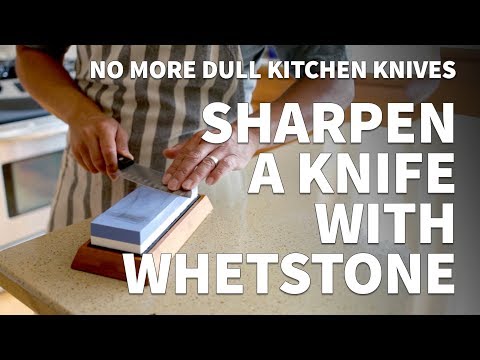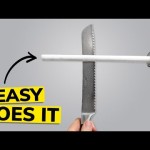
b2b206e0e2870479f0d338863fcf2db3
Having a sharp knife is essential for any kitchen. Whether you are a professional chef or a home cook, having a sharp knife can make all the difference in the quality of your food preparation. A good whetstone is the best way to sharpen your knife and keep it in top condition. In this article, we will discuss the basics of sharpening your knife with a whetstone, including the types of whetstones available, the proper technique for sharpening, and the importance of maintaining your knife.
Is whetstone best for sharpening knives
Sharpening knives is an important part of kitchen maintenance. A sharp knife is safer and more efficient to use than a dull one. There are many ways to sharpen a knife, but one of the most popular is using a whetstone.
A whetstone is a flat stone made of natural or synthetic materials. It is used to sharpen knives by grinding the blade against the stone. The stone is usually soaked in water before use, which helps to keep the blade cool and prevents it from becoming too hot.
The advantage of using a whetstone is that it can be used to sharpen any type of knife. It is also very easy to use and can be done at home. The downside is that it can take a long time to sharpen a knife, and it can be difficult to get the blade to the desired sharpness.
Another popular method of sharpening knives is using a sharpening steel. This is a metal rod with a rough surface that is used to hone the blade. It is much faster than using a whetstone, but it is not as effective at sharpening the blade.
In conclusion, a whetstone is the best option for sharpening knives. It is easy to use, can be used to sharpen any type of knife, and can achieve a very sharp edge. However, it can take a long time to sharpen a knife, and it can be difficult to get the blade to the desired sharpness.
Can I ruin my knife with a whetstone
Sharpening a knife with a whetstone is a great way to keep your knife in top condition. However, it is possible to ruin your knife if you don’t use the right technique. In this article, we’ll discuss how to use a whetstone correctly and how to avoid ruining your knife.
What is a Whetstone?
A whetstone is a sharpening stone used to sharpen knives and other tools. It is made of a hard material such as silicon carbide or aluminum oxide. The stone is usually rectangular or triangular in shape and has two sides: a coarse side and a fine side. The coarse side is used to sharpen dull blades, while the fine side is used to hone and polish the blade.
How to Use a Whetstone
Using a whetstone is a simple process, but it is important to follow the correct steps to avoid damaging your knife. First, you should soak the stone in water for 10-15 minutes. This will help to keep the stone from clogging with metal particles. Next, you should place the stone on a flat surface and hold the knife at a 20-degree angle against the stone. You should then move the blade in a circular motion, applying light pressure. After a few passes, you should flip the stone over and repeat the process on the other side.
Can I Ruin My Knife with a Whetstone?
Yes, it is possible to ruin your knife with a whetstone if you don’t use the correct technique. Applying too much pressure or using the wrong angle can cause the blade to become dull or even chip. It is also important to use the right type of stone for your knife. Using a stone that is too coarse can cause the blade to become dull quickly, while using a stone that is too fine can cause the blade to become too sharp.
Conclusion
Sharpening a knife with a whetstone is a great way to keep your knife in top condition. However, it is important to use the right technique and the right type of stone to avoid damaging your knife. If you follow the steps outlined above, you should be able to keep your knife sharp and in good condition.
What grit whetstone is best for sharpening knives
Sharpening knives is an important part of kitchen maintenance. A whetstone is a great tool for sharpening knives, but it can be difficult to know which grit to choose. The grit of a whetstone is the measure of its abrasiveness, and it is important to choose the right one for the job.
The most common grits for sharpening knives are 1000, 2000, and 3000. A 1000 grit whetstone is the coarsest and is best for knives that are very dull or damaged. It will remove a lot of material quickly, but it will also leave a rougher edge. A 2000 grit whetstone is a good all-purpose option for most knives. It will remove material quickly and leave a smooth edge. A 3000 grit whetstone is the finest and is best for knives that are already sharp. It will remove very little material and leave a very smooth edge.
When choosing a whetstone, it is important to consider the condition of the knife. A 1000 grit whetstone is best for knives that are very dull or damaged, while a 3000 grit whetstone is best for knives that are already sharp. A 2000 grit whetstone is a good all-purpose option for most knives.
It is also important to consider the type of knife. A 1000 grit whetstone is best for knives made of softer materials, such as stainless steel. A 3000 grit whetstone is best for knives made of harder materials, such as carbon steel. A 2000 grit whetstone is a good all-purpose option for most knives.
Finally, it is important to consider the user’s skill level. A 1000 grit whetstone is best for beginners, as it is the easiest to use and will remove material quickly. A 3000 grit whetstone is best for experienced users, as it will leave a very smooth edge. A 2000 grit whetstone is a good all-purpose option for most users.
In conclusion, the best grit whetstone for sharpening knives depends on the condition of the knife, the type of knife, and the user’s skill level. A 1000 grit whetstone is best for knives that are very dull or damaged, a 3000 grit whetstone is best for knives that are already sharp, and a 2000 grit whetstone is a good all-purpose option for most knives.
How long should I soak a whetstone
Sharpening tools is an important part of maintaining them, and a whetstone is one of the most popular tools for sharpening. But before you use a whetstone, you need to soak it in water for a certain amount of time. So, how long should you soak a whetstone?
The amount of time you should soak a whetstone depends on the type of stone you are using. Oil stones should be soaked for at least 20 minutes, while water stones should be soaked for at least 5 minutes. If you are using a diamond stone, you don’t need to soak it at all.
It is important to note that you should never soak a whetstone for too long. If you soak it for too long, the stone can become saturated with water and will not be able to absorb any more. This can cause the stone to become soft and lose its sharpening properties.
When you are done soaking the whetstone, you should dry it off with a clean cloth. This will help to remove any excess water and will help to keep the stone in good condition. You should also store the whetstone in a dry place when not in use.
Soaking a whetstone is an important part of sharpening tools. Knowing how long to soak a whetstone will help you get the best results from your sharpening efforts. Be sure to follow the instructions for the type of stone you are using and never soak it for too long.
Thank you for reading this article about sharpening your knife with a good whetstone. We hope that you now have a better understanding of the process and the tools you need to get the job done. Goodbye and have a great day!







